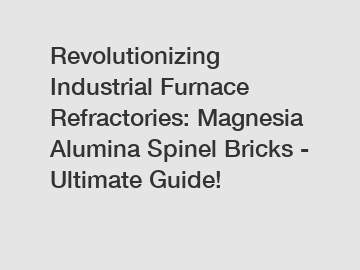Revolutionizing Industrial Furnace Refractories: Magnesia Alumina Spinel Bricks - Ultimate Guide!
Revolutionizing Industrial Furnace Refractories: Magnesia Alumina Spinel Bricks - Ultimate Guide!
Industrial furnaces play a crucial role in various industries, such as steelmaking, glass manufacturing, and cement production. The efficiency and durability of these furnaces greatly rely on the quality of the refractories used. In recent years, a revolutionary material known as magnesia alumina spinel bricks has emerged, offering improved performance and longevity compared to traditional refractory bricks. In this ultimate guide, we will explore the origins of magnesia alumina spinel bricks, their scientific basis, and the significant impacts they have had on the industrial furnace industry.
Magnesia alumina spinel bricks are composed of magnesia and alumina with a spinel phase. The formation of spinel makes these bricks highly resistant to thermal shocks, alkali attacks, and corrosion, allowing them to withstand extreme temperatures and harsh chemical environments. The discovery of this unique composition and its exceptional properties can be attributed to extensive research and experimentation in the field of materials science.

Scientists have conducted in-depth studies on the phase diagrams of magnesia and alumina, understanding how the addition of certain elements can shift the equilibrium and promote the formation of spinel. They have also experimented with different manufacturing processes, such as sintering and hot pressing, to optimize the physical and chemical properties of magnesia alumina spinel bricks. These efforts have led to the development of advanced production techniques and a deeper understanding of the structure-property relationship of refractory materials.
The significance of magnesia alumina spinel bricks goes beyond their exceptional performance. The increased lifespan and stability of industrial furnaces achieved through the use of these bricks lead to reduced downtime and maintenance costs for industries. This not only improves productivity but also contributes to sustainable practices by minimizing resource consumption and waste generation.
Furthermore, the use of magnesia alumina spinel bricks can have a positive impact on the environment. The traditional refractory bricks often contain hazardous substances like chromium, which can pose threats to human health and the ecosystem. By adopting the use of spinel-based bricks, industries can mitigate these risks and create safer working environments.
In conclusion, the advent of magnesia alumina spinel bricks has revolutionized the industrial furnace refractory sector. Their unique composition and exceptional properties have been the result of dedicated research in materials science. The utilization of these bricks has brought about significant benefits in terms of furnace efficiency, longevity, cost savings, and environmental sustainability. As industries continue to embrace this innovation, we can expect further advancements in refractory materials and increased efficiency in industrial processes.
For more information, please visit high alumina bricks, castable refractory cement, ceramic fibre blanket dealer.

Comments